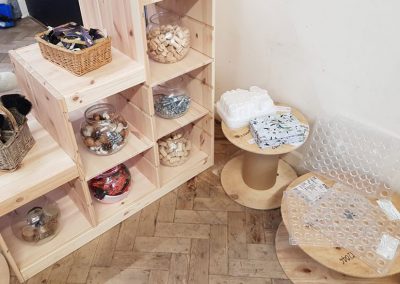LOOSE PARTS play
Loose parts are materials that can be moved, carried, combined, redesigned, lined up, and taken apart and put back together in multiple ways. They are materials with no specific set of directions, they can be natural or synthetic.
When children are left alone to play with whichever loose part they choose, it encourages them to use their imagination, explore their creativity and learn things about their environment, for example, ‘what will happen if I drop this stone into a puddle?’ or using flowers to explore their senses.
Although we encourage plenty of adult-led activities, we should provide the children time to be children. Here are some examples of loose parts and heuristic play:
Help! There’s mold on my natural materials!
Article by Penny Whitehouse from Mother Natured
“You’re rummaging around to find some wood slices and pinecones that you know are behind the wooden blocks. You need them for an activity tomorrow.
You reach far around the corner and can feel a pinecone in your hand. You start grabbing them out one by one until you notice grey dust on your hands.
Looking down at the materials, you notice that every single one has bits of mold growing inside and around the cracks.
You’re not pleased.
These materials were perfect for your lesson. You wonder if you can clean them, or if you’ll need to throw these away and get new ones.
If you’re anything like me, you probably have a heap of natural materials and wooden toys – they’re natural, durable, and they stimulate creativity and children’s senses.
But what’s the best way to clean your natural materials and wooden toys when mold creeps in?
And when should you give up and throw them away?
Well, firstly, let’s start from the beginning – prevention is the key.
Try not to get your natural materials wet. If you’ve just collected some pinecones and they are a little damp due to a light rain shower or dew, be sure to dry them with a clean, dry cloth and let them completely dry out in the sun. No sun? A hair dryer works well too.
Molds cannot survive in dry conditions, so if your classroom has a lot or airflow and gets a good amount of sunlight, you’re probably going to be okay.
However, if the environment in your classroom is humid or there’s little sunlight and airflow, this is the perfect growing environment for mold. Once your materials are completely dry it’s best to keep them in an airtight container.
Now on to cleaning the mold off your natural materials:
- If you find mold on your natural materials or wooden toys, use a soft brush to rub off the mold from the toys. This should be done outside to prevent mold being deposited in other parts of the classroom. Be gentle so that you don’t damage the materials
- White vinegar is a mild acid that is known to kill roughly 82 percent of mold species, and it can even help prevent mold outbreaks in the future. Never soak or immerse wooden toys and natural materials in water. Wood is porous – so a soaking might cause them to swell and change shape. Simply spray them with 10:1 mixture of water and distilled white vinegar, wipe with a cloth and warm water, then air dry.
- Drying your materials in the sun speeds up the drying process and the sun is a natural way to kill more germs. However strong sunlight or prolonged exposure can lead to colour fade and cracking – so only keep it out until they are dry, then pack them away.
If there are still visible signs of mold after a wipe down and some sun, it may be best to collect some new materials and throw the moldy ones outside to breakdown in environment. They’re already biodegrading, after all.
As I mentioned, prevention is the key, so be sure to get your materials dry and keep them in a dry space in the classroom or in an airtight container.
That way, you’ll have the materials ready to use whenever you need them and those little hands back with their favourite natural materials in no time!






